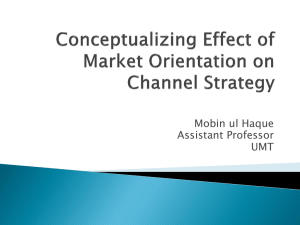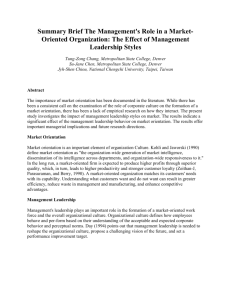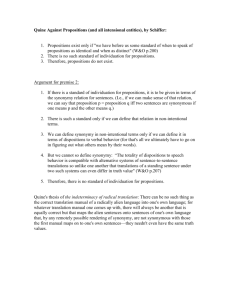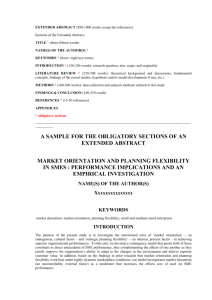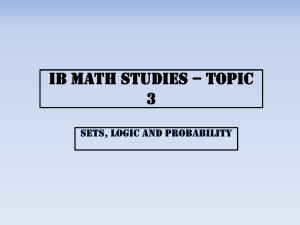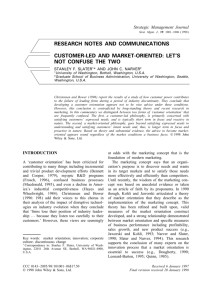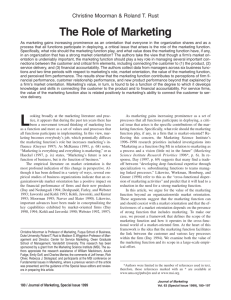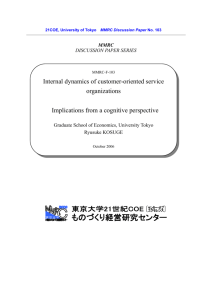a model of market orientation and firm value
advertisement
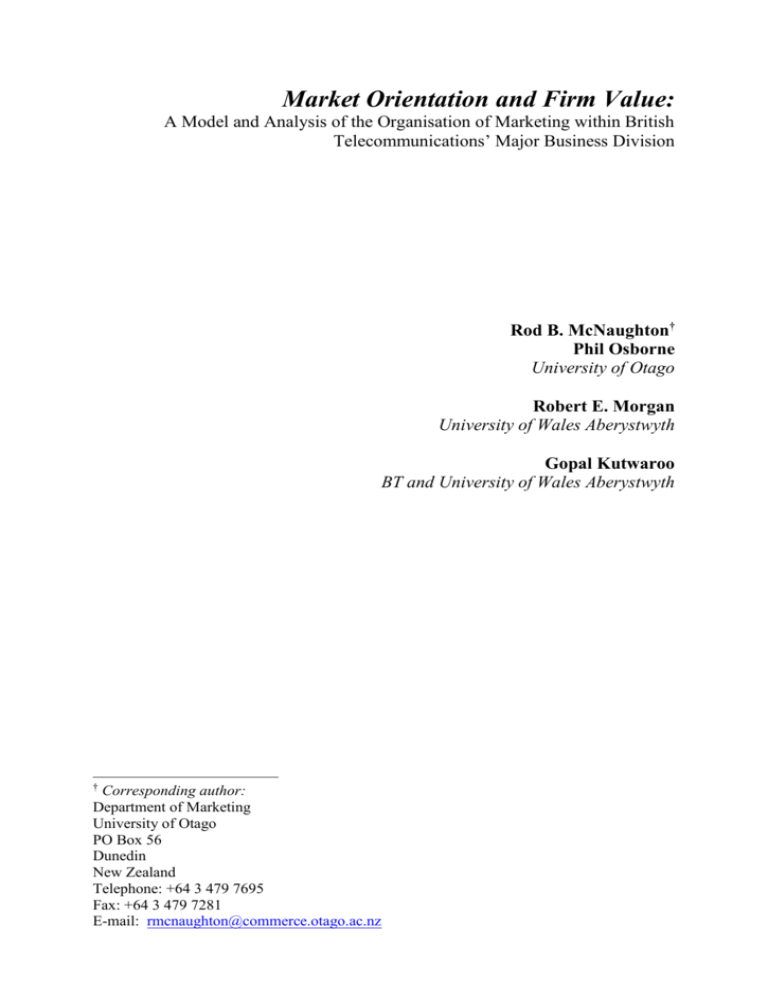
Market Orientation and Firm Value: A Model and Analysis of the Organisation of Marketing within British Telecommunications’ Major Business Division Rod B. McNaughton† Phil Osborne University of Otago Robert E. Morgan University of Wales Aberystwyth Gopal Kutwaroo BT and University of Wales Aberystwyth † Corresponding author: Department of Marketing University of Otago PO Box 56 Dunedin New Zealand Telephone: +64 3 479 7695 Fax: +64 3 479 7281 E-mail: rmcnaughton@commerce.otago.ac.nz Market Orientation and Firm Value: A Model and Analysis of the Organisation of Marketing within British Telecommunications’ Major Business Division ABSTRACT Several studies in the market orientation literature demonstrate a positive relationship between a market orientation and firm performance. However, the mechanisms of this relationship have yet to be explored in detail. This article addresses this gap by proposing a conceptual model that links a market orientation to wealth creation in firms. The model posits that a market orientation guides investment in market-based assets that may be deployed to create customer value. The realisation of customer value helps to both capture and retain customers. Quicker and more extensive market penetration, shorter sales cycles, and decreased marketing and sales costs enhance the cash flow of a market-oriented firm. This may be recognised in higher valuations, which ultimately translate into higher share prices and wealth creation for the owners of the firm. This model is used to describe the creation of value in the Major Business Division of British Telecommunications PLC (BT), a large information technology service company. Recent success at BT is attributed to the creation of a market orientation and customer value-based strategy and processes. The experience of BT provides a clear illustration of how a market oriented firms creates value for both customers and shareholders. INTRODUCTION An important theme in contemporary marketing theory is the potential for a market orientation to positively influence business performance (Narver and Slater, 1990; Jaworski and Kohli, 1993; Deshpandé, Farley and Webster, 1993). The logic of this influence is that a market orientation facilitates the collection and use of market information, and focuses the co-ordination of resources to deliver superior customer value (Slater and Narver, 1994, 1995). The veracity of this logic is tested in empirical studies that hypothesise market oriented firms perform better than their internally focused rivals on financial measures such as profit, relative profit, return on investment or assets, and non-financial measures such as new product success and innovation. Empirical results generally confirm a positive relationship with these measures of performance (Ruekert, 1992; Deshpandé, Farley and Webster, 1993; Jaworski and Kohli, 1993; Slater and Narver, 1994; Pelham and Wilson, 1996), though occasionally the relationship is not statistically significant (e.g., Diamantopoulous and Hart, 1993; Greenley, 1995). We argue that existing explanations of how market orientation influences performance are incomplete. Extant theory focuses on the processes whereby market orientation creates customer value, but then makes a substantial leap in positing a relationship between value for customers and the creation of value for the owners of the firm (i.e., through increased profitability and returns). The processes that underlie this relationship are largely treated as a black box, though the improbability of a direct causal link (e.g., as postulated by Narver and Slater, 1990 and Ruekert, 1992) is acknowledged by exploration of potential moderators (e.g., Day and Wensley, 1988; Diamantopoulos and Hart, 1993; Greenley, 1995, Jaworski and Kohli, 1993). 1 The purpose of this article is to present a conceptual model that makes explicit the processes whereby a market orientation and an emphasis on customer value can create wealth for the owners of firms. While many researchers have focused on specific and limited areas of market orientation research (e.g., the refinement and validation of the MARKOR scale [Matsuno, Mentzer and Rentz, 2000]), this model adopts an eclectic perspective to explain the effects of market-based assets on the cash flow of a firm (Srivastava, Shervani and Fahey, 1998). By focusing on cash flow, specific mechanisms are identified whereby a market orientation can influence the financial position of the firm, and thus create wealth for shareholders. This line of inquiry is part of an emerging theme within the marketing literature (c.f. Marketing Science Institute, 2000), which seeks improved metrics for assessing marketing and its impact within the firm (Ambler, 2000), and attempts to better understand the role of marketing in creating shareholder value (Doyle, 2000). The framework developed in this article enhances the theory of market orientation by providing a more detailed account of the market orientation-firm performance relationship. It also contributes to management practice by: (1) phrasing the effects of a market orientation in the nomenclature of cash flow which is understood by managers in all functional areas of the firm, (2) emphasising that marketing expenditures are investments, and (3) providing a framework that can be used to guide and analyse the strategies of market-oriented firms. To illustrate the usefulness of this model as an analytic framework, we apply it to interpret the case of British Telecommunication PLC’s (BT) Major Business division (BT– MB) which deals with major organisational purchasers of IT products and services. This unit has undergone a transformation from a product oriented business to a market oriented one with a focus on customer value-based strategies. Our knowledge of this transformation and the business practices of BT-MB are based on participant observation by one of the authors, and published accounts. A MODEL OF MARKET ORIENTATION AND FIRM VALUE The emerging consensus is the concept of a market orientation constitutes a fundamental strategic approach to understanding markets (Vorhies, Harker and Rao, 1999). This orientation can be described as an organisational culture focused on understanding the market which helps firms to develop customer value strategies that take advantage of opportunities and repel threats (Woodruff, 1997). The dimensions of this orientation have been extensively studied (e.g., Narver and Slater, 1990; Kohli and Jaworski, 1990; Ozkowski and Farrell, 1998; Matear, Boshoff and Gray, 1997). The most consistent dimensions are an emphasis on gathering market intelligence about customers, monitoring of competitors and dissemination of market knowledge across departments and work groups. The implication for performance is that the presence of these characteristics enables market-oriented organisations to build a sustainable competitive advantage by: (1) learning what customers want, (2) creating business models that deliver the value customers desire, (3) monitoring and reacting to current and potential competitors, and (4) adapting the value generating process as market conditions change (Day, 1994; Hunt and Morgan, 1995). Thus, the natural point of theoretical departure for a conceptual model of market-oriented wealth creation is the dimensions of market orientation. 2 Figure 1 presents a conceptual model that maps a path from market orientation to firm value. This model has four main components: a market orientation, market-based assets, customer value and firm value. We develop arguments to link each of these components. …Insert Figure 1 about here… The established logic is that a market orientation provides the basis for devising a customer value strategy, and that such a strategy provides the foundation for a sustainable competitive advantage that contributes to financial performance. (For example, see the hypotheses related to business performance developed by Jaworski and Kohli, 1993, or by Deshpandé, Farley and Webster, 1993.) This explanation masks as much as it reveals by not articulating the mechanisms by which a firm can realise value for its shareholders when pursuing a customer value strategy. These mechanisms are not readily apparent within the literature. Kohli and Jaworski (1990, 1993), for example, found that an emphasis on profitability was “conspicuously absent” as a component of a customer value-based business strategy. Thus, the relationship is unlikely to be direct. Indeed, only relatively recently has the literature on market orientation been extended to consider its organisational consequences such as the business strategies that are pursued (Matsuno and Mentzer, 2000). A customer value-based strategy can be logically linked directly to the creation of market-based assets. Market-based assets are largely intangible, and consist of intellectual assets (knowledge about the market), relational assets (outcomes of relationships with stakeholders including channel members, customers, and other players), and the interaction between these asset forms (Srivastava, Shervani and Fahey, 1998). Market-based assets accumulate by developing knowledge, skills and resources that are unique and difficult to imitate (Barney, 1991; Hunt and Morgan, 1995). They can be built or acquired through various forms of investment, including staff time spent in relationship building, databases, advertising and promotion, sponsorship and such like. Market-based assets can create value for a firm by: (1) building strong barriers to entry that divert competitors to higher cost or less effective strategies (Grant, 1991, 1996), (2) leveraging the asset (Srivastava, Shervani and Fahey, 1998) and, (3) deploying the asset to create customer value (Slater, 1997). The last of these is of most interest to us as it is the method by which a market orientation influences the way in which a firm interacts with its customers. One of the most useful frameworks for understanding value in service markets is the customer perceived value ratio which has evolved from pricing theory (Monroe, 1991). This measure is the ratio between perceived benefits and perceived costs or sacrifice; where the ratio favours the former over the latter, it can be claimed that value has been generated. Customer perceived benefits might include factors such as a product’s physical (core) attributes, service (intangible) attributes and technical support available, the purchase price, and relative quality characteristics of the product offering. On the other hand, customer perceived sacrifice includes the specific costs the buyer is faced with upon completion of the purchase and ownership of the product offering (e.g., acquisition costs, order processing and handling, risk of service failure or poor performance, and the opportunity costs involved in the purchase decision.) The components of the ratio recognise that it is the total cost of ownership that is of importance and not purely the purchase price. In service markets this is particularly relevant as the total cost of ownership can be a critical ingredient in the purchase decision (Ellram, 1993). In considering the role of marketing in this respect, the means have to be established 3 to determine how the perceived benefits and/or the total costs of ownership can be increased and/or decreased respectively. Importantly, the potential scope for marketing arises in that both the numerator and denominator in this customer value equation should be considered ‘relative’ to competitors. As Christopher (1996, p. 59) explains: “In seeking to deliver significantly superior customer value the marketer must clearly define, communicate, and deliver a “value proposition” which is recognised by the target market as a better proposition than that presented by competitors. It should also be recognised that in most markets there will be different value segments but that to be successful in any one of them the customer value ratio must be seen to be superior to competitive offerings.” Focussing upon both benefits and costs provides marketers with opportunities, especially since the process of value determination is a consequence of a perceptual process implying that positioning, presentation and communication are all fundamental properties of the value proposition. Market-based assets can be used in many ways to generate value for customers, and to leverage value from a firm’s tangible assets. Each firm’s business model is at least partially unique in both the character of assets and the way they are deployed. Ways in which market-based assets can create value for customers include lowering search costs, better matching of performance requirements and price (Day, 1994), improved service, trust, innovative new products (Slater and Narver, 1994), and risk reduction. The growing literature on customer value is fragmented with limited consensus as to what is meant by terms such as benefits, utility, customer worth, and customer value. In specifically addressing the nomenclature surrounding customer value, a number of advances have been made centring on how customers articulate value (e.g., Gardial, Clemons, Woodruff, Schumann and Burns, 1994 and Richins, 1994a/b). These authors use a definition that encompasses both desired and received customer value, and draw upon the notion that value is derived from the learned perceptions, preferences and evaluations of customers. Furthermore, an association is made between product offerings per se and the context in which they are used (Woodruff and Gardial, 1996). Woodruff (1997, p. 142) proposes a definition of customer value that is inherently customer-driven: “Customer value is a customer’s perceived preference for and evaluation of those product attributes, attribute performances, and consequences arising from the use that facilitate (or block) achieving the customer’s goals and purposes in use situations.” A customer orientation is a central ingredient of a customer value-based proposition. The link between these concepts is that “…customer orientation places the highest priority on continuously finding ways to provide superior customer value” (Han, Kim and Srivastava, 1998, p.33). While customer orientation is combined with competitor orientation and interfunctional teamwork in a market orientation (Narver and Slater, 1990), others consider it to be the single most crucial element of a firm’s corporate culture (Lawton and Parasuraman, 1980; Deshpandé, Farley and Webster, 1993). There are three trigger points in which customer orientation can add value to a proposition: (1) Firm-customer interface (external marketing). Traditional marketing activities take place by means of marketing research driving research and development, which in turn determine the marketing mix program of product, price, distribution and communication. (2) Firm-employee interface (internal marketing). Viewing employees as a market in their own right stimulates an innovative view of value perception and encourages the firm to evaluate how value can be provided to the customer via the functions in the value chain. 4 (3) Employee-customer interface (interactive marketing). Face-to-face interaction and other forms of encounter with the boundary spanners representing the firm are critical agents in the value creation and delivery process. The ultimate goal of a customer orientation program focused on value creation is customer satisfaction. Customer value and customer satisfaction are concepts that are related to one another. The literature postulates that firms providing customer value have more satisfied customers who demonstrate stronger brand loyalty (Aaker, 1991). This has a number of potential effects on cash flow that can both increase incoming cash and decrease outgoing cash. For example, loyal customers are less likely to switch and require less ongoing marketing effort to retain (Reichheld and Sasser, 1990). Thus, there is a growing pool of customers who by word-of-mouth act as marketing agents that help to attract new customers. The possible effects on cash flow of a growing share of loyal customers are numerous (Figure 1). The literature on both brand equity and customer satisfaction, for example, reveal that loyal or satisfied customers will pay price premiums (Farquhar, 1989), adopt line extensions more readily (Keller, 1993), try and refer products more frequently, and have lower sales and service costs (Reichheld and Sasser, 1990). The overall effect of these processes is to speed receipt of cash, widen the gap between incoming and outgoing cash (for marketing related expenditures), and reduce working capital and fixed capital requirements. All else being the same, this should create higher earnings for market-oriented firms, reduce the volatility of their cash flow, and increase the residual value of their cash flow (Srivastava, Shervani, and Fahey, 1998). These characteristics of cash flow are key levers of firm value (Day and Fahey, 1988). THE ORGANISATION OF MARKETING IN BT’s MAJOR BUSINESS DIVISION Over the last twenty years information technology (IT) companies such as BT-MB have generally pursued a common approach to business marketing. The focus has been commonly product-centric, and heavily focused on technological innovation. Due to the increasing turbulence of the IT climate and an enormous proliferation in customer demands and expectations, those organisations adopting a product-centric approach are now performing below the competitive bar within the industry. Identifying competitor referents and strategic group analysis are problematic when considering this sector given that competitive boundaries change regularly because of market shifts, strategic alliances, and breakthrough changes in infrastructure, systems and methods of going to market. BT–MB deals exclusively with major corporate customers and government agencies. Within BT–MB a goal of shareholder value dominates but more recently is juxtaposed with an emphasis on customer value creation. BT–MB now recognises that marketing has an essential role to play, and this is illustrated by the corporate slogan “marketing makes the difference”. The creation of a new marketing unit within BT–MB is part of a recent strategy to improve the company’s performance by making it more responsive to its customers. This Marketing Directorate is an example of the company’s shift away from a traditional product orientation to an organisation focused upon the value propositions offered to customers. In the following sections we apply our model to describe BT-MB’s market orientated organisational structure. We begin by focusing on how BT–MB transformed itself from a product oriented to a market oriented company. The difference in these orientations is that a product-oriented company sells on the basis of technological advancements/functionality and pricing, while a market-oriented company focuses explicitly on the business drivers of their customers and builds tailored propositions to address those concerns. A market-oriented 5 company will deploy the best available technology, but will not overemphasise this when the customer does not value it. Pricing is difficult for both the product and market oriented IT firm, and for MT-MB pricing remains a process of competitive bidding. But, a market-oriented firm can build IT that stimulates demand. Furthermore, BT-MB has introduced “risk and reward propositions”, in which payments are linked to savings or productivity gains experienced by customers. Such contracts penalise under-performance and reward demonstrable productivity. Most examples are in the area of supply chain management outsourcing where percentage fees are charged based on ultimate savings. The transition from product to market orientation at BT-MB was clearly marked in 1999 with the creation of an organisation structure to facilitate “proposition selling in marketing”. This superstructure is designed to deal with major businesses, which are typically customers that spend more than US$1m per annum with BT-MB on IT/Telecommunication services. The organisation is commonly referred to as Central Marketing because it has both marketing- and sector-based teams in all lines of business, and is responsible for creating pan-functional propositions (propositions that work across all different types of business). For example, energy management propositions designed to save customers expenditure on lighting, electricity and like utilities using telematic devices. Central Marketing plays a lead role in setting direction and stimulating demand for IT services focused on “new wave” activity. These are propositions designed to stimulate revenues in the mobile, data and information processing arenas. The new marketing structure that has developed is aimed at increasing the customer base and providing new solutions that add value for corporate customers. We next consider how the dimensions of market orientation – customer, competition, and co-ordination – are implemented in BT-MB’s approach. Market Orientation There are multiple entry points within Central Marketing for information about customer requirements. A new initiative is the development of Insight Interactive. This is a Web-portal designed to explain the propositions BT–MB has to offer. Within these propositions, customers can tailor their own requirements. Most propositions are in the form of case studies that can be adapted. The portal also provides the primary research media for white paper development. These white papers are one avenue for market requirement definitions to be completed and feasibility studies made. Customer needs and requirements can also be collected from: (1) Product lines such as BT Ignite and BT Openworld which are corporate engine houses for all of BT-MB’s products and services. These organisations primarily function by analysing demand fluctuations for their services and building accordingly. (2) Relationship Marketing divisions which are designed to introduce customers into various business driver scenarios and industry events. Here BT-MB typically invites academics from leading research institutions and industry gurus to work with customers in business planning and solution scenarios. The main interface for customer commitment resides with the BT-MB account manager. This is a “one-stop-shop” for customers for both sales and service. Satisfaction is measured through scorecards and various Internet media. Competition with BT-MB is carefully monitored through various news portals by the COMBAT Internet portal group who diagnose competitor service offerings. Also media analysis is performed, so the company develops a comprehensive database of competitor information, features, products, propositions and pricing. 6 Co-ordination is a main feature of BT-MB’s new marketing practice. Information sharing takes place via a regular forum and internal relationship marketing events. An example of these is Changing Perspectives events where Marketing makes presentations about the power of new propositions and introduces new ways of selling. Information sharing now occurs over the Web via static content and video streaming. Marketing engages sales in developmental discussions with product houses and the relevant industry. More trials now result. Projects to integrate functional areas are underway, and interaction between previously disparate groups result from this activity. Market-Based Assets BT-MB has market-based assets in two primary forms: intellectual capital and relational capital. To manage its intellectual capital BT-MB has invested heavily in knowledge management applications based on Intranet/Extranet technology to share information on customers, competition and the business climate. BT-MB also provides this as a commercial capability, so customers can do the same. Infopower is another medium which is a news based services/prime corporate communications vehicle designed to keep everyone in the sales and marketing community apprised of organisational news. Most of BT-MB’s relational capital can be found in the Relationship Marketing and Marketing Communications units which have a remit to group headquarters to ensure that messages being sent out are consistent, regulatory approved and are compliant with the holistic strategic direction of the company. Corporate image is crucial and the company has established a Brands and Reputation Directorate to address these needs. An example of corporate image is the latest business marketing campaign “BT You Can”. This branding is of major significance and the associated logo is displayed at all times in communications to the business community. This ensures that BT has a harmonious business marketing practice. Within this You Can strategy advertisements can only come from Marketing. Consequently, product lines are no longer able to advertise in the business press, and must fit into one of four approved themes. This represents a significant departure from the traditional productmarketing route, and demonstrates the emphasis placed on marketing over products and services and the marketing of propositions. In terms of leveraging market-based assets, more focus is now placed on the integration of the information obtained for wider marketing campaigns. BT-MB has strong capability in data warehousing and data mining, for example, that results in unique call centre/supply chain activity. Due to the strict regulation of the industry, BT needs to satisfy its regulator on the dissemination of certain information that it holds on customers. Analysts estimate that corporate branding within BT generates approximately $US14 million of business revenue year-on-year. Brands are also leveraged through affinity marketing. Customer Value Customer value is key to all activity within the Marketing organisation. Where BT-MB add value needs to be demonstrated, mostly by fiscal measures such as economic value equations that measure customer benefits. Risk and reward related propositions are increasingly common as the margins on IT services are becoming much tighter and the market saturated with product/service offerings. BT-MB categorises customer value strategies into four key proposition areas that either drive cost out of the customers’ organisations or contributes to revenue. These four areas are Customer Relationship Management, Supply Chain Management, Organisational 7 Effectiveness and Knowledge Management. We describe each of these briefly, as the propositions are also applied to create customer value within BT-MB. Customer Relationship Management. Customer Relationship Management (CRM) is a company-wide business strategy to deliver a highly personalised service that exceeds customer expectations and creates and maximises customer lifetime value. CRM underpins an organisation’s relationship with its customers. The framework BT-MB uses to understand CRM is based on three main areas: (1) CRM Strategy. This concerns the strategic vision required at Board level to adopt and implement a Customer Relationship Management approach. Financial investment and business process re-engineering to challenge and change current business thinking across all of its operations are required. (2) Customer Information and Profiling. This is the process of collating, managing and analysing customer information held across the business to understand customer profitability and lifetime value. By harnessing this customer knowledge, organisations are able implement targeted one-to-one marketing programmes that deliver long and profitable relationships through acquiring new customers, retaining customers and managing less profitable customers. (3) Customer Contact Solutions. This concerns the personalisation and integration of the multiple touchpoints that every company has with its customers, for example, retail branches, direct operations (customer service or telemarketing), Web sites, digital TV, Internet mobile phones, kiosks, etc. to provide a seamless view of interactions/transactions. The main issue addressed by the CRM proposition is how organisations can optimise customer loyalty using e-business solutions while integrating the Web with their existing legacy business (e.g., retail branches). This requires an understanding of the dynamics of multiple routes to market and co-ordination of the communication and operational channels. To manage this effectively, BT-MB helps organisations to review internal process management to both build and manage customer intelligence systems and integrate backoffice enterprise resource planning (ERP) systems. The dramatic growth of the Internet means that companies face customer demand for their products on a global scale. This creates issues in managing order fulfilment processes, billing and maintaining customer service levels in domestic markets and overseas. In this context, enhanced customer service skills are critical to deepen customer interactions and build long and profitable relationships. Supply Chain Management. Recent advances in the convergent technologies of telecommunications and computing together with the growth of information processing has led to an unprecedented change in the way in which business-to-business and business-toconsumer transactions are conducted. Nowhere is this more evident than in the area of Supply Chain Management (SCM). Innovative technological solutions are reducing time to market and costs, while enabling greater responsiveness to customer demands. This results in an increased awareness of how the company does business, of possible threats to it from competitors and new entrants radically altering the existing model. Supply chain strategy provides the link between corporate objectives and the tactical processes needed to operate the business. The focus is usually on a limited, manageable set of operational tasks that meet the order winning criteria of customer segments. Any change in the way a company does business will radically alter its cost base, distribution network and ultimately its position on the supply chain. It may move downstream and address consumers, directly cutting out its traditional wholesaler/retailer distribution network, or may migrate upstream providing new services and possibly outsourcing its direct sales force. 8 Innovative supply chain strategies, policies and procedures are key drivers in increasing shareholder value through profitable growth, cost minimisation, working capital efficiency, fixed capital efficiency, and tax minimisation. BT’s experience suggests that improvements in SCM can reduce external costs by 5-15%, purchasing costs by 90%, and the cost of sales by 50%. Organisational Effectiveness. The primary focus of Organisational Effectiveness (OE) is to enable organisational flexibility and agility, leading to greater shareholder value. This covers a large area of the customers’ business. The two prime areas are work processes (the applications and functions that deliver value for BT customers), and work styles (how an organisation operates in a “people and places” sense). OE is about getting the best value from support processes, functions and assets and hence the best value services to and from employees. Customers who respond to OE value propositions develop an advantage over time by managing strategies, particularly at the operating level to ensure that they are created, funded, resourced, targeted and tracked. Knowledge Management. Knowledge Management (KM) is about making people and organisations smarter through new ways of working supported by new technology. Knowledge Management positions a company to respond to the fast emerging opportunities and threats of the knowledge economy. Its intention is to make people and organisations more efficient and enterprising by linking people with technology in ways that generate distinctive competencies and capabilities. The result is to mobilise new and better ways of thinking, working and competing. KM is strategically important to any organisation wishing to succeed in the knowledge economy, as knowledge underpins the ability to compete. At an economic level this is due to the fundamental shift in the traditional basis of wealth creation from land, labour and capital - towards learning, innovation, collaboration, integration and the leverage of intellectual assets. BT-MB’s approach, developed into a KM framework, takes these needs into account. Ultimately, KM addresses the most important business issue facing organisations - the need to reconfigure internal capabilities faster than the pace of change in the external world. Customer Retention and Customer Attraction Retaining customers is key to BT-MB’s strategy on loyalty. The company consistently designs propositions to reward customer loyalty, mostly in respect to staggered pricing and migrating networks. Examples of campaigns include the latest From Legacy to Dotcom campaign. This seeks to move companies away from proprietary networking to advanced concepts such as the creation of virtual businesses. BT-MB also tries to reduce switching to other telecommunication service providers for the same basic services. In the IT market, margins are tight and competition thrives on price, not technology. There are costs associated with retaining customers too: continuous maintenance of older style legacy technology, customers who are not ready to migrate to newer networks and the associated marketing effort. Recruitment can sometimes be difficult in these areas and selling costs are high. Attracting new customers is the main focus of company efforts. BT-MB has financial engines in place to display what is incremental value based on technology and proposition selling. Customer trials are a feature and the vast scale of investments in Web portal design means that customers also have a unique experience in interacting with the company. …Insert Figure 2 about here… 9 Firm Value Firm value and market orientation have been traditionally difficult are to measure. What we are able to claim is that at BT-MB over $US225m has been attributed to incremental value since the implementation of the Central Marketing organisational structure. The value of total sales is approximately $US4.5 billion. Deductively this represents that Marketing is associated with 5% of the new total sales effort. But this does not capture the softer side of marketing such as the contributions of Relationship Marketing and Marketing Communications units. For this purpose, BT uses the Corporate Scorecard as a framework for analysis. This scorecard is divided into four value areas: shareholder perspective, customer perspective, innovation and learning and, the internal process perspective. The shareholder perspective includes three measurable areas of success. The first is the revenue growth of traditional products and services. The second is revenue of “new wave” activity (including mobile and data applications, revenue obtained through third party alliances, Insight Interactive and Marketing propositions). Thirdly, marketing is measured by “contribution” to overall revenue, which is not necessarily direct as stipulated in the measures above. This includes contribution from various marketing programmes at both incremental and momentum level. Within this marketing measure cost comes into play. Managing cost involves managing the Major Business marketing budget to effectively meet revenue and profit targets. Part of this is reducing the cost of sales through alternative routes and measuring return on investment, usually from direct response campaigns. The fourth area of activity, shareholder value, is closely associated with Marketing’s virtual activity. This includes revenue driven from the online presence, the number of customers online and the proportion of sales made online. The second part of the corporate scorecard measures the customer perspective. The first goal here for Marketing is to deliver excellent client relationship management. This is measured in three ways. Firstly customer loyalty, which measures the value of marketing communication as perceived by the customer. Secondly, the usage of Insight Interactive. Lastly the impact of Marketing’s Thought Leadership Programmes. This is marketing activity designed to stimulate interest from senior decision-makers, via the You Can campaign, various public relations activities, Insight Executive programmes, Insight Magazine and Insight Interactive. The second goal is marketing’s role in securing competitive advantage. This includes new case studies from the value propositions created and measuring the value of public relations activity. The third part of the scorecard includes the internal process perspective. There are five goals that must be fulfilled by Marketing. Firstly, measuring internal customer responsiveness by a Client Review Process (CRP) which looks at service to the customer. Secondly, internal processes capability and consultative selling. This involves looking at the CRP activity and examines the speed and professionalism of the company. Thirdly, Marketing as an organisation that cares; here a comprehensive CARE survey administered by Human Resources measures satisfaction, equal opportunities and culture within the job. Also included is the remit of Training, which considers the number of managers professionally qualified with chartered status and those pursuing similar marketing qualifications. The fourth area is sector liaison and product line support for marketing. This is measured via the number of senior managerial meetings, customer-competitor-market views, and prospectsportfolio reporting. The last part of the scorecard deals with the innovation and learning perspective. There are four goals under this. Firstly, propositions that are measured by delivery of 10 propositions to the sales account teams within BT–MB. Specifically this concerns creating and delivering propositions within the new wave areas (mobile and data). Closely related is the second goal of delivering compelling value propositions based on feedback from Insight Interactive which account teams can take to customers. Thirdly, developing an e-channel that meets customer needs and provides information from a marketing portal environment. Lastly, the advent and practice of shared learning. An example is the You Can Win Sales Zone (YCWSZ). Specific measures include the incremental case study contribution, number of YCWSZ registered users, increases in interaction on the YSWSZ Web site by registered users, use of the separate Major Business Web site, and training events for account managers. CONCLUSIONS This article presented a model that traces the theoretical effects of market orientation on firm value. The model furthers our understanding of the market orientation-performance relationship by making explicit the mechanisms whereby a customer value strategy can influence a firm’s financial position. This addresses a gap in the stream of research that seeks to demonstrate a positive empirical relationship between market orientation and measures of financial performance (e.g., Narver and Slater, 1990 and Ruekert, 1992; Day and Wensley, 1988; Diamantopoulos and Hart, 1993; Greenley, 1995, Jaworski and Kohli, 1993). The model postulates that a market-oriented firm is able to build market-based assets that can be deployed to create customer value. A customer value strategy results in more loyal and satisfied customers that are more receptive to marketing initiatives and cost less to service (Reichheld and Sasser, 1990). Such favourable customer characteristics enhance and accelerate net cash flow, increase the residual value of cash, and decrease the volatility of the cash flow. These are key levers of firm value (Day and Fahey, 1988). Market-based assets can also create value for the firm by establishing barriers for competitors, and can be directly leveraged through increased demand for stock, co-branding, and sales of data or expertise. This model is illustrated by the Marketing structures and processes created by BT– MB in trying to move from a product-oriented to a market-oriented approach to business. The organisation of Marketing within BT-MB is summarised in Figure 2. The experience of BT provides an example of how the various components of our model can be operationalised. Our emphasis in this article is a description of the organisational structures BT created to support its stated goal of shifted to a more market-oriented culture. Further research will track and report on the functional linkages between the component, and the actual experience of how the structure creates value for customers and the firm. Our model emphasises cash flow, which has two clear benefits. First it provides the ability to communicate the benefits of marketing expenditures across functional areas within a firm. The language of cash flow is universal. Second, it emphasises that marketing expenditures are investments whose net present value can be estimated. This provides a common framework for firms to compare the benefits of a market orientation with alternative internally focused strategies (or indeed, the complementary effect of a market orientation on investment in tangible assets). As yet, BT-MB has not pursued a means of directly monitoring the effect of marketing activities on cash flow. However, they have implemented a sophisticated Corporate Scorecard to provide multiple measures of performance relative to different stakeholder groups. Our model also emphasises that the benefits of a market orientation, like investments in tangible assets, are not realised in the same period as the investment. For example, many dot.com companies have a business model that articulates a customer value strategy, and an organisational culture that is strongly market oriented. However, in early accounting periods 11 they have a high cash burn rate as they invest externally raised equity in the creation of market-based assets. Studies that seek to correlate market orientation with traditional measures of financial performance would find a negative relationship for such firms. This model provides a framework for analysing the strategies that these firms pursue, and a way of understanding how they may eventually realise the value placed on them by their investors. This observation is also relevant to the massive investments BT-MB has made in its Internet presence, and the lag effect in realising the benefits of this are recognised within the Corporate Scorecard. The full implementation of our model as a strategic framework would require an accounting method that is able to relate changes in cash position to specific marketing activities. Goebel, Marshall and Locander (1998) recently addressed this issue by describing how activity-based costing can assist analysis of the costs and benefits of a market orientation. The cost-per-customer and revenue-per-customer metrics that are being used to both value and track the performance of Internet-based firms are also relevant. These metrics make a direct link between the costs of marketing activities and the benefits derived in terms of customer retention, and the frequency and quality of sales (Whyman, 1999). REFERENCES Aaker, D.A. (1991) Managing Brand Equity: Capitalising on the Value of a Brand Name. NY: The Free Press. Ambler, T. (2000) Marketing Metrics, Prentice-Hall/Financial Times, London. Barney, J.B. (1991) Firm Resources and Sustained Competitive Advantage, Journal of Management, 17, 99-120. Christopher, M. (1996) From Brand Values to Customer Value, Journal of Marketing Practice: Applied Marketing Science, 2 (1), 55-66. Day, G. S. (1994) The Capabilities of Market-Driven Organizations, Journal of Marketing,58, 37-52. Day, G.S. and Fahey, L. (1988) Valuing Market Strategies, Journal of Marketing, 52, 45-57. Day, G.S. and Wensley, R. (1988) Assessing Advantage: A Framework for diagnosing Competitive Superiority, Journal of Marketing, 52, 1-20. Deng, S. and Dart, J. (1994) Measuring Market Orientation: A Multi-Factor, Multi-Item Approach, Journal of Marketing Management, 10, 725-742. Deshpandé, R. and Farley, J.U. (1998) Measuring Market Orientation: Generalization and Synthesis, Journal of Market Focussed Management,2, 213-232. Deshpandé, R., Farley, J.U. and Webster Jr, F.E. (1993) Corporate Culture, Customer Orientation, and Innovativeness in Japanese Firms: A Quadrad Analysis, Journal of Marketing,57, 23-27. Diamantopoulos, A. and Hart, S. (1993) Linking Market Orientation and Company Performance: Preliminary Evidence on Kohli & Jarworski's Framework, Journal of Strategic Marketing, 1, 93-121. 12 Doyle, Peter (2000), Value-Based Marketing, Wiley, New York. Ellram, L. (1993) Total Cost of Ownership: Elements and Implications, International Journal of Purchasing and Materials Management, 29 (9), 1-25. Farquar, P.H. (1989) Managing Brand Equity, Marketing Research, 1, 24-33. Gardial, S.F., Clemons, D.S., Woodruff, R.B., Schumann, D.W. and Burns, M.J. (1994) Comparing Consumers’ Recall of Pre-purchase and Post-purchase Evaluation Experience, Journal of Consumer Research, 20 (March), 548-560. Goebel, D., Marchall, G.W., and Locander, W.B. (1998) Activity-Based Costing: Accounting for a Market Orientation, Industrial Marketing Management, 27, 497-510. Grant, R.M. (1991) The Resource-based Theory of Competitive Advantage: Implications for Strategy Formulation, California Management Review, Spring, 114-135. Grant, R.M. (1996) Prospering in Dynamically-Competitive Environments: Organisational Capability as Knowledge Integration, Organisational Science, 7, 375-387. Gray, B. J., Matear, S., Boshoff, C. and Matheson, P. (1999) Developing a Better Measure of Market Orientation, European Journal of Marketing,32, 884-903. Greenley, G. E. (1995) Market Orientation and Company Performance: Empirical Evidence from UK Companies, British Journal of Management,6, 1-13. Han, J.K., Kim, N. and Srivastava, R.K. (1998) Market Orientation and Organizational Performance: Is Innovation a Missing Link?”, Journal of Marketing, 62 (October), 30-45. Hunt, S.D. and Morgan, R.M. (1995) The Comparative Advantage Theory of Competition, Journal of Marketing, 59, 1-15. Jaworski, B. J. and Kohli, A. K. (1993) Market Orientation: Antecedents and Consequences, Journal of Marketing, 57, 53-70. Keller, K.L. (1993) Conceptualizing, Measuring, and Managing Customer-Based Brand Equity, Journal of Marketing, 57, 1-22. Kohli, A. K. and Jaworski, B. J. (1990) Market Orientation: The Construct, Research Propositions, & Managerial Implications, Journal of Marketing, 54, 1-18. Lawton, L. and Parasuraman, A. (1980) The Impact of the Marketing Concept on New Product Planning, Journal of Marketing 44 (Winter), 19-25. Marketing Science Institute (2000), Research Priorities 2000-2002, MSI, Cambridge, Massachusetts. Matear, S. M., Boshoff, C., Gray, B. J. and Matheson, P. (1997) Models of Market Orientation: A Comparative Study, in Eighth World Marketing Conference Kuala Lumpur, Malaysia. 13 Matsuno, K. and Mentzer, J. T. (2000) The Effects of Strategy-Type on the Market Orientation-Performance Relationship, Journal of Marketing, 64 (October), 1-16. Matsuno, K., Mentzer, J. T. and Rentz, J. O. (2000) A refinement and Validation of the MARKOR Scale, Journal of the Academy of Marketing Science, 28 (4), 527-539. Monroe, K.B. (1991) Pricing: Making Profitable Decisions, McGraw Hill, New York. Narver, J. C. and Slater, S. F. (1990) The Effect of a Market Orientation on Business Profitability, Journal of Marketing, 20-35. Oczkowski, E. and Farrell, M. A. (1998) Discriminating Between Measurement Scales Using Non-Nested Tests & Two Stage Least Squares Estimators: The Case of Market Orientation, International Journal of Research in Marketing, 15, 349-366. Pelham, A. M. and Wilson, D. T. (1996) A Longitudinal Study of the Impact of Market Structure, Firm Structure, Strategy, & Market Orientation Culture on Dimensions of SmallFirm Performance, Journal of the Academy of Marketing Science,24, 27-43. Reichheld, F. F. and Sasser, E.W. (1990) Zero Defections: Quality Comes to Services, Harvard Business Review, 68, 105-111. Richins, M.L. (1994a) Special Possessions and the Expression of Material Values, Journal of Consumer Research, 21 (December), 522-533. Richins, M.L. (1994b) Valuing Things: The Public and Private Meanings of Valuing Possessions, Journal of Consumer Research, 21 (December), 504-521. Ruekert, R. W. (1992) Developing a Market Orientation: An organizational strategy perspective, International Journal of Research in Marketing, 9, 225-245. Slater, S.F. (1997) Developing a Customer Value-Based Theory of the Firm, Journal of the Academy of Marketing Science, 25, 2, 162-176. Slater, S. F. and Narver, J. C. (1994) Does Competitive Environment Moderate the Market Orientation - Performance Relationship, Journal of Marketing,58, 46-55. Slater, S.F. and Narver, J.C. (1995) Market Orientation and the Learning Organisation, Journal of Marketing, 59, 63-74. Srivastava, R.K., Shervani, T.A., and Fahey, L. (1998) Market-Based Assets and Shareholder Value: A Framework for Analysis, Journal of Marketing, 62, 2-18. Vorhies, D.W., Harker, M., Rao, C.P. (1999) The Capabilities and Performance Advantages of Market-driven Firms, European Journal of Marketing, 33, 11/12, 1171-1202. Whyman, B. (1999) Net Businesses Need New Valuation Metrics, The Industry Standard, June 14. Woodruff, R.B. (1997) Customer Value, The Next Source for Competitive Advantage, Journal of the Academy of Marketing Science, 25, 139-153. 14 Woodruff, R.B. and Gardial, S.F. (1996) Know Your Customer: New Approaches to Customer Value and Satisfaction, Blackwell, Cambridge. 15 Figure 1. A Model of the Influence of a Market Orientation on Firm Value. MARKET ORIENTATION CUSTOMER -listening -service -commitment -satisfaction COMPETITION -monitoring CO-ORDINATION -info sharing -involvement -integration -interaction MARKET BASED ASSETS Barriers -diverts competition to higher cost strategy -retain good employees Intellectual capital - knowledge - customers - competitors - environment Relational capital - brands - corporate image - channel equity - installed base Leverage -demand for stock -co-branding -potential brand sales -sales of data -recruit good employees CUSTOMER VALUE - reduced search costs - risk reduction - responsiveness - improved targeting - improved service - trust Word of mouth Attract new customers Retain customers increase incoming cash - price premiums - line extension - cross- selling - companion selling - up-selling - increased purchase frequency - reduced switching reduce outgoing cash increase incoming cash - recruitment costs - servicing costs - selling costs - faster trial, adoption and diffusion -market share reduce outgoing cash - shorten sales cycle - inventory - selling costs - innovation costs - fewer failures FIRM VALUE - earnings - accelerated cash in - residual value of cash - volatility of cash flow 17 Figure 2. The Implementation of a Market-focused Organisation at BT Customers Insight Interactive BT Ignite and Openworld Relationship Marketing unit Competition COMBAT Co-ordination Changing Perspectives events Intranet investments Internal marketing programmes Market-based Assets Intellectual Assets Knowledge management Infopower Data warehousing and data mining Relational Assets Relationship marketing Marketing Communication unit Brands and Reputation Directorate Customer Value Customer relationship management Supply chain management Organisational effectiveness Knowledge management Customer Retention Reward loyalty with staggered pricing Help migrating between networks Customer Attraction Proposition based selling Customer trials Customised Web portals Firm Value Measurement Incremental turnover Corporate Scorecard - shareholder perspective - customer perspective - innovation and learning - internal processes 18
